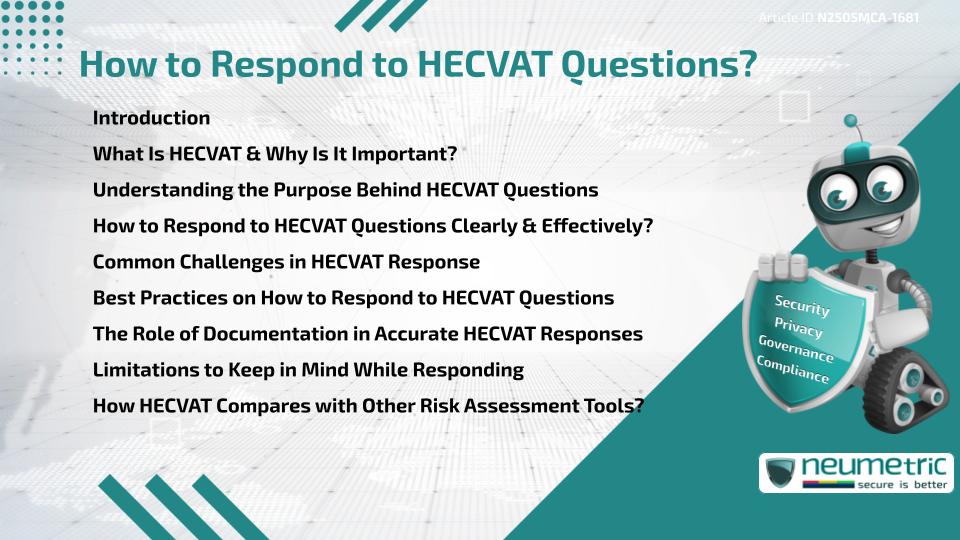Table of Contents
ToggleIntroduction
For Vendors offering Digital Products or Cloud Services to Colleges & Universities, the Higher Education Community Vendor Assessment Toolkit [HECVAT] is a common requirement. Institutions use it to evaluate the Security Posture of Third Party Services. Knowing How to respond to HECVAT Questions is essential for building trust & reducing approval time.
What Is HECVAT & Why Is It Important?
HECVAT is a standardised Questionnaire developed by EDUCAUSE to help Higher Education Institutions assess Vendor Risks. It focuses on Data Security, Privacy Controls & Compliance with Standards like FERPA, GDPR & ISO 27001. Vendors must show how they handle Sensitive Data & meet Compliance needs.
Understanding the Purpose Behind HECVAT Questions
Each Question in the HECVAT form serves a purpose. Some check for general Practices like Data Encryption, while others focus on Access Controls or Incident Response. To know How to respond to HECVAT Questions, Vendors must understand that Institutions aren’t just looking for Yes/No answers. They want to know How Protections are implemented.
For Example, if asked about Multi-factor Authentication, it’s not enough to say it’s in place. You need to describe where it’s used, how often & whether it’s required for all Users.
How to Respond to HECVAT Questions Clearly & Effectively?
When thinking about How to respond to HECVAT Questions, clarity is more important than length. Follow these basic rules:
- Use Plain language over Technical terms
- Avoid vague words like “we try” or “usually”
- Reference specific Controls or Processes
- Attach relevant Documentation where possible
It helps to align your responses with known Frameworks like NIST CSF when applicable. These make your answers easier for reviewers to understand & verify.
Common Challenges in HECVAT Response
One Challenge is misinterpreting a Question. If you are unsure, it’s better to ask the Institution for Clarification. Another issue is overloading the response with irrelevant details. When learning How to respond to HECVAT Questions, always focus on what the Question actually asks.
Also, small Vendors may struggle with Questions that assume a High level of maturity. In these cases, it’s better to explain your current Controls honestly & note where improvements are planned.
Best Practices on How to Respond to HECVAT Questions
Here are some trusted Practices:
- Prepare a Central Document Library for Policies & Procedures
- Reuse accurate, approved responses from past HECVAT submissions
- Include links to External Certifications such as SOC 2
- Make sure your Internal Teams (legal, IT, Compliance) contribute
This will save time & reduce errors in how you respond.
The Role of Documentation in Accurate HECVAT Responses
Documentation backs your claims & shows that your Organisation takes Security seriously. If you say you perform regular Security Training, include a Policy or Sample content. If you Encrypt Data, link to your Encryption Standards. This is key to mastering How to respond to HECVAT Questions.
Limitations to Keep in Mind While Responding
HECVAT may not always match your Product or Service. For instance, some questions may assume a hosted SaaS Model, while your Product is Installed locally. In such cases, clarify your architecture & explain why some questions may not apply. Transparency is more valuable than a forced answer.
How HECVAT Compares with Other Risk Assessment Tools?
Unlike tools such as CAIQ or NIST Self-assessments, HECVAT is tailored to Education-sector needs. Learning How to respond to HECVAT Questions also prepares you for other Frameworks, as many Themes overlap.
Takeaways
- Know how to respond to HECVAT Questions by focusing on clarity, accuracy & purpose
- Align your answers with Security Frameworks where possible
- Prepare & Maintain reusable, Well-documented responses
- Use support from Compliance & Security Teams
- Avoid vague or overly Broad Statements—be specific & honest
FAQ
What is the best way to understand How to respond to HECVAT Questions?
Start by Reviewing the Full Question, understanding the goal behind it & referencing Internal Documentation or Policies that support your answer.
Can Templates help me learn How to respond to HECVAT Questions?
Yes. Many Vendors build Internal Templates from past submissions which make future responses faster & more consistent.
Do I need to answer every question to know how to respond to HECVAT Questions?
Not always. If a Question is Not Applicable, say so clearly & explain why. That shows honesty, not weakness.
Are Technical Terms required when figuring out How to respond to HECVAT Questions?
No. Use clear, non-technical language unless the question specifically calls for technical detail.
How can small Vendors manage How to respond to HECVAT Questions?
Focus on what Security Controls are in place & explain any limitations. Highlight ongoing improvements & provide honest timelines.
Should answers change based on the HECVAT Version?
Yes. The Lite Version is simpler & suits Low-Risk Tools, while the Full Version may need more detailed responses.
What kind of Documents should I attach when learning How to respond to HECVAT Questions?
Policies, Security Certifications, Training Schedules, Encryption Practices & Incident Response Plans.
Need help?
Neumetric provides organisations the necessary help to achieve their CyberSecurity, Compliance, Governance, Privacy, Certifications & Pentesting goals.
Organisations & Businesses, specifically those which provide SaaS & AI Solutions, usually need a CyberSecurity Partner for meeting & maintaining the ongoing Security & Privacy needs & requirements of their Clients & Customers.
SOC 2, ISO 27001, ISO 42001, NIST, HIPAA, HECVAT, EU GDPR are some of the Frameworks that are served by Fusion – a centralised, automated, AI-enabled SaaS Solution created & managed by Neumetric.
Reach out to us!


